
Comic books are set to self-destruct mode the moment they are made, storing them properly will help preserve them for years to come - but how do you do it, how can you be a comic book hero!? The value of some collections can easily run into £1000s, and some individual highly collectible rare editions can be worth the same on their own. It’s worth getting your comic book storage right and our complete guide is here to help!
There are established ways of storing collections, we’re going to discuss the pros and cons of all of the options available, why it’s important to get things right, and how to delay the self-destruct timer that is on each of your comics!
> | View all Comic book storage products here
Part 1 - Preparation for storing your comic collection
Like most things in life, a lot of unseen and valuable work is in the preparation, getting this right means your comic books will last longer and be better protected. Getting it wrong could lead to your collection being destroyed without you even realising.
Handling comics

Most damage to comics is caused by handling, so how do you reduce the risks?
Before we do anything, let’s get some basics set out. When you’re doing anything with your comics you need to set up your work/viewing area to prevent any damage, and you need to handle them with care.
- Set up a clean, dry, flat work surface, preferably white paper so you can see and remove any dirt or liquid that might otherwise make its way onto your comic books.
- Put your cup of coffee in another room until you’re finished! Same with any ink pens or other items that may spill or mark paper.
- Clean your hands (as if we haven’t had enough of that advice!) and invest in some nitrile gloves, or finger cots to prevent oils from transferring from your skin to your comics. Cotton gloves can lead to a reduction in dexterity and therefore when handling thin papers, such as the papers of your comics, it’s best to use nitrile. You can view them here.
Cleaning your comic collection - Store your comics, not dirt!
Comics that have been read or not stored properly previously will require cleaning before being stored properly. Contaminants on the paper can lead to damage over time, they may not be particularly visible at the moment or only seem minor, but it is best to clean them away before storage.
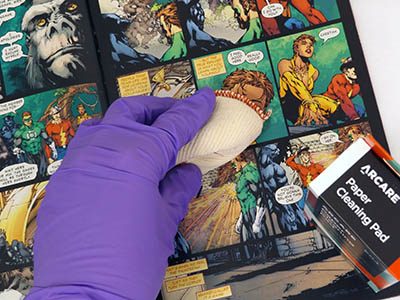
- Those innocent fingers that have flicked the pages will have left oil on the paper’s surface. The oil from your fingers could eventually lead to staining in the paper and could attract dust. Using a paper cleaning pad like this one gently clean away any surface debris and oils.
- Dust should also be cleaned from any exposed surfaces, like the pages edges and spine, as this can attract pests and support mould growth. With a soft dusting brush which won’t damage the paper’s surface, gently clean away any debris making sure that the spines are all clean too. The spine can be a magnet for any detritus from previous handling, dust, hair, fingernails, ewww!
- If a comic has been damaged by mould and contains active mould growth, care should be taken when cleaning, mould can be hazardous to human health. Mould must be removed before storing your comics, any stains resulting from mould growth could be reduced by cleaning and washing the paper.
Washing paper is generally a job for a trained conservator. The process of washing will also remove some of the acids that have accumulated in the paper making it last longer.
Repairs to your damaged comic books - and the evils of tape!
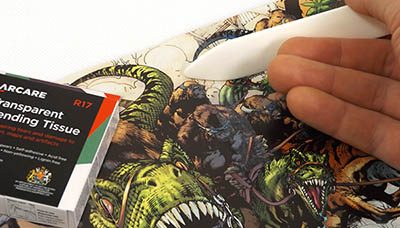
Small tears can be repaired using an archival acid free tape like this one. Repairing tears will reduce the risk of them becoming worse as the paper ages and becomes weaker in storage. It’s important to choose an acid free, archival quality repair tape for this purpose, standard self-adhesive tapes will cause irreparable damage and staining over time. For a professional standard repair, Japanese tissue, like this
Tengu gummed tape may be used - trickier to apply but with a better result
Non-archival quality tapes that have been used to repair comics will cause irreparable damage, they need to be removed. The adhesives in non-archival tapes will eventually dry, becoming yellow and stain the paper which can be impossible to remove. Some adhesives can become acidic as they degrade which will damage the paper.
Removing tape is generally a job for a professional paper conservator. A conservator will be able to remove tapes from comics using a combination of techniques that will not cause further damage (such as heat, steam, solvents). The treatment would be dependent on the tape that has been used and its age.
Choosing your comic book storage area
Very few people will have given this much thought, their boxes containing their valued collections are under the bed, at the back of a cupboard or (eeek!) in a garage or loft. You’ll need to choose an appropriate place for your comics to live. Poor storage conditions will speed up and facilitate the ticking timebomb of comic destruction! Dramatic enough?!
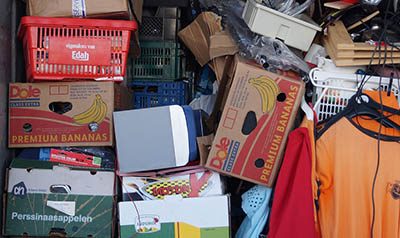
Here are some important points to remember:
- Avoid sources of leaks or water, i.e. pipework, windows, roof spaces - reduce potential risks for damp
- Avoid cold external walls particularly if they are north facing, this can cause condensation and mould when air cannot circulate properly
- Avoid places which see extreme changes in temperature or high temperature i.e. lofts, garages, near radiators – fluctuating temperature and humidity can speed up natural degradation damaging the paper and cause condensation/mould
- Avoid areas of high RH (relative humidity – more information below)
- Avoid areas with known insect and pest infestations such as silverfish (which can be indicative of other problems) - pests can destroy a collection without you even realising, monitor the area.
- Choose an area away from direct sunlight, the heat and UV radiation will damage your comics
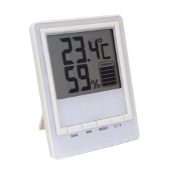
The ideal area for your comics will; be away from direct sunlight, have a stable, low temperature and a stable RH. RH is ‘relative humidity’ and is a measure of the amount of water present in the air. An RH of around 40%-50% is good you can easily monitor an area using a thermohygrometer to see if it’s suitable.
You can also monitor the storage area using pest traps that will alert you to any potential issues or infestations. Silverfish can eat their way through your collection, these traps will attract, trap and kill Silverfish.
Now you have cleaned and prepared your comics for storage, prepared your storage area, and know the best conditions to keep your comics, onto the next step...
> | View all Comic book storage products here
Part 2 - What should you store your comics in?
There are some basic rules that apply to the archival storage of most papers including comics. It’s a lot more complex than it might seem at first, but getting this right will mean your collection will be safe. Get it wrong and you could actually cause damage to your collection.
Acid - is it eating away at your collection?
Acid is your comic book’s nemesis, it will degrade the very fabric of the paper your comics are made of causing them to become yellow, and eventually weakening it so much the paper disintegrates. Comics are/were unfortunately not made to last, usually constructed from cheaper paper which contains impurities that will speed up the process of degradation. There are things you can do to slow this process significantly, but incorrect storage will only serve to speed the damage up.
A few general tips on the storage materials first:
- Ensure all storage materials are acid free and inert (I.e. acid free and will not become acidic with age like PVC or non archival quality paper)
- Ensure any paper or card backing or box is buffered to prevent acids from developing or migrating to your comic
- Make sure your storage box protects against UV light (UV can be from sunlight or present in some electric lighting)
- Make sure the enclosure is neither too tight (causing pressure points) or too loose (allowing the comic to move inside)
The ‘Bag and board’ method
Traditionally comic books are stored upright in a ‘bag’ with a section of board to support them. This is a method that has been accepted across the comic collecting world and it does have some merits.
- It allows for simple viewing making handling easier and less risky
- Protects from dust and pests
- The weight of the comic is only exerted on itself and the backing board and the comic is supported when being handled.

A couple (well more than a couple) of things; Always make sure the backing board is acid free, lignin free (won’t become acidic) and buffered (will neutralise acids). Make sure the bag is not made from PVC (you will know that 'plastic smell') or other plastic with plasticisers that will become acidic – Polyethylene, polypropylene and polyester are all OK, Polyester being the best. Archival polyester, sometimes known by the brand names Mylar or Melinex is stiffer and clearer than the others.

The range of BCW comic collecting storage materials has all sizes available for bag and board type storage, you can buy them from us from our UK stock here.
Got it in the bag?
I’m going to throw the cat amongst the pigeons here – Bagging and boarding is probably not the way a museum would store a comic book. There, I’ve said it.
A general rule in conservation of paper is that you store it in paper. A museum would most likely store a comic within an acid free folder, inside a box. This is perfect, if you don’t want to see and handle your collection, remember, handling causes damage too. They would then be stored flat in a box, like this one. You could look at this method of storage if you are not going to be handling your comics.
If you have a very valuable comic, it is always best to consult the services of a conservator who will be able to advise you of the best way to store it.
Comic Boxing – the final piece of the puzzle
As per previous advice, the final piece of your storage, the box, needs to be acid free, inert and preferably buffered to prevent acids from developing.
A few other general tips:
- Ensure the box is strong enough to cope with the weight of the collection and won’t split when being moved (dropping your comics would be a disaster!)
- Smaller boxes (20-50 comics) are easier to move, won’t hurt your back and less likley to get dropped
- Make sure the box is of the correct size. If too large you can gently pack the space with acid free tissue to prevent unwanted movement
- Ensure that comics are not packed in tightly, you should be able to comfortably remove and replace comics in the box
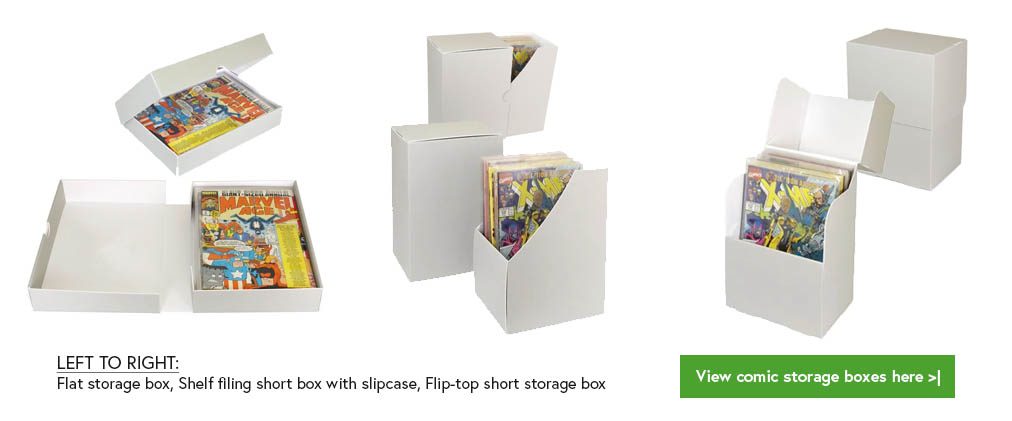
Comic storage boxes are commonly called 'Long boxes', and 'Short boxes'. We always recommend the use of Short Boxes.
Here's why; Short boxes reduce the risk of accidental damage when handling them, they are lighter and less prone to comics becoming crushed and damaged inside - Our flip top short box is the most popular design, but our shelf file also looks great! Both of those boxes are for traditional bagged and boarded storage. Our flat storage box allows the best access to your comics and is probably more like a museum type storage solution. The box reduces issues when removing or replacing comics - best for delicate editions, you can view flat storage box here. We also offer a comic storage box binder and binder storage pockets for convenient viewing and archival storage. If you cannot find a box to suit your comics we can also make completely made-to-measure boxes on our boxsite.co.uk bespoke box service.
We’ve been supplying boxes to museums and archives for decades so we know what makes a good storage box for your comic collection. We’ve designed these boxes specially for comic storage, view them here.
> | View all Comic book storage products here
Now you know how to store your comic books correctly. View all of our comic book collection products here.